Explainer
- Explainer
- Science
Could we ever journey to the centre of the Earth?
We’ve landed humans on the moon but we’ve barely scratched the surface of our own planet. What lies beneath, and what mysteries remain?
You are standing on a churning sea of molten metal hundreds of kilometres deep. Fortunately, that’s not all you’re standing on. There’s some rock too – a lot of it, actually. And crystals. More than a few dinosaur bones as well. But deep under all that, in the very heart of our blue planet, burns a core as hot as the surface of the sun.
In his 1864 novel Journey to the Centre of the Earth, Jules Verne imagined a lost cavern of dinosaurs, giant crystals and a sprawling subterranean sea beneath our feet. The truth is just as strange. “It’s a planet within a planet,” says geophysicist Professor Hrvoje Tkalcic at the Australian National University. Within Earth is a core of crystallised iron almost as big as the moon with its own spin and structure, distinct from the rest of the planet but generating an electromagnetic force field that makes life on the surface possible. “And, if we could see it, it’d be like looking at the sun,” says Tkalcic.
Only in the past century have we even known it existed. Because of the extreme temperatures and pressures beneath the surface, it’s harder to get to than outer space. We probably know more about the rest of the solar system than Earth’s own interior.
But Verne’s imaginings weren’t all fanciful; there really are giant crystals and even a huge “ocean” of sorts hidden inside the Earth’s mantle. Now, as an ambitious drilling project similar to early Cold War expeditions gathers steam and laboratories up at the surface come closer to simulating the punishing conditions of the core (using diamonds and guns), scientists hope to crack open even more of the planet’s secrets. What’s the Earth made of? Is it really a giant magnet? Could we ever journey to its centre?
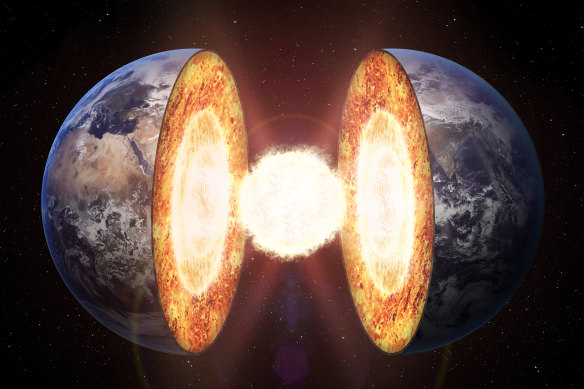
The Earth’s inner core is as hot as the surface of the sun and would be as bright to look at, scientists say.Credit:
What’s inside the Earth and how do we know?
The Earth formed, with the rest of the rocky things in our solar system, out of the leftover dust and gas that made our sun some 4.6 billion years ago. That early molten ball of fire cooled enough to get a crust of rock on its surface while heavy elements, such as iron and nickel, sank deeper in its gut to forge the core.
But it’s plain that Earth is also different to everything else we see in the solar system. Ablaze with life – with oceans, atmosphere, animals and shifting rocks – there’s an engine at Earth’s heart that’s more than just the dying fire of its formation. As astrophysicist Professor Jonti Horner says, Earth may be one of the luckiest planets in the universe. Even a cataclysmic early collision with another planet the size of Mars, known as Theia, seemed to set the right conditions for life (and forged our stabilising moon from the debris).
We do know that when our planet is rocked by big earthquakes, it rings like a bell as shock waves bounce around the interior.
We can’t see into the Earth and, so far, deep drilling projects and even Verne’s idea of journeying down volcano shafts into the magma chambers below haven’t worked. (More on that later.) But we do know that when our planet is rocked by big earthquakes, it rings like a bell as shock waves bounce around the interior. Just as X-rays and soundwaves can reveal the shape of whatever they pass through, these “seismic waves” give us a window into the Earth, geophysicist Professor Arwen Deuss explains. “It’s like a light going on.” The denser the material, the faster seismic waves will travel through it, allowing scientists to gauge the properties within.

Seismic waves refracted inside the Earth are picked up by sensors (green dots) at the surface listening for the rumble of earthquakes (red dots).Credit: Hrvoje Tkalcic, Drew Whitehouse
You’ve likely seen the four layers of the Earth in school textbooks, in neat circles of red and yellow. We live on the crust, the thin rocky skin of our planet. It’s broken up into the slow-drifting tectonic plates that make and remake the continents. But the crust runs only about 35 kilometres deep on average (thickest beneath mountain chains and thinnest on the ocean floor). It’s another 6000 kilometres to the very centre. “The crust [accounts for] just 1 per cent of the planet’s mass,” says Horner. “We’re like bacteria clinging to the outside of an apple.”
In 1909, geologist Andrija Mohorovicic noticed that waves on seismographs suddenly sped up beyond the crust, as if they’d hit a barrier. He’d found the Earth’s next layer: the mantle (the boundary of which is now known as the “Moho” discontinuity, in his honour). The mantle glitters green, largely made of a rock called olivine, but with red flecks of garnet throughout, Deuss says. And it’s on the move itself, in a crawl over millions of years that Tkalcic compares to fingernails growing as the tectonic plates shift overhead, pulling up new crust to the surface and dragging down the old as part of the planet’s vital carbon cycle. “Think of it as a conveyor belt,” he says. “Or a hot soup on the boil where things rise to the surface and others sink. And at the very bottom is a graveyard.”
Ancient slabs of crust and tectonic plates lie broken where the mantle ends, alongside two mysterious continent-sized blobs that straddle the core like a pair of earmuffs. No one quite knows what these “mantle anchors” are, says Deuss, but we know their density and chemistry is different to the surrounding rock (thanks not only to seismic waves but tantalising samples hurtled to the surface via volcanoes). According to one theory, they could even be the remains of that lost alien planet Theia, which may have fused with a young Earth or been swallowed whole during the ancient collision.
Next, just over halfway through Earth, you hit the core – a sea of liquid metal burning at thousands of degrees Celsius. Its swirling motion generates an electric current and gives rise to our magnetic field (more on that below). Further in, about 2500 kilometres, is the inner core, where the weight of the planet is so great that the melted metal freezes solid, even though the temperatures are, literally, astronomical. “Here the pressure takes over … like a neutron star,” Tkalcic says. “The atoms are so tightly packed in. Imagine an atmosphere more than 3.5 million times heavier than at the surface”, thousands of times more pressure than at the very bottom of the ocean.
Danish seismologist Inge Lehmann discovered the inner core in 1936 when she noticed seismic waves refracting off its boundary. Deuss and Tkalcic, separately, have since confirmed that the inner shell is solid by spotting special waves there, known as shear waves, which travel only through solids. In fact, this iron ball has been growing as the Earth slowly cools, eating into the liquid outer core by about one millimetre every year.
There’s a fifth layer down there too – an innermost inner core only recently discovered.
Scientists have learned about the ingredients of planets by studying asteroids and meteorites (themselves often the broken cores of ancient worlds lost in cosmic collisions, says Horner). The density of Earth’s core tells them it’s likely made of iron and nickel with some lighter elements mixed in, such as oxygen, silica or sulfur. Because of how fast iron conducts heat, they can tell the inner core is younger than the Earth from its size. Best estimates suggest it started to solidify between 1.5 billion and 500 million years ago.
But there’s a fifth layer down there too – an innermost inner core only recently discovered “like a pip in a piece of fruit”, Deuss says. It’s not as clear a boundary as the others, which can refract seismic waves back like a mirror. If it were, it would have been discovered earlier, Tkalcic says. “Now we need to change those school textbooks and make four layers five.”
Here, scientists think the crystal in the core changes, perhaps due to a slightly different elemental mix, or because it has grown at a different angle, horizontally instead of vertically. That shift in crystallisation could speak to a past calamity, Tkalcic says. “The Earth may have melted and remelted more than once in its early history as all these collisions were happening. And this is the oldest part of the inner core. It’s like a time capsule.”
Deuss and her team at the University of Utrecht recently created a 3D image of the Earth’s elusive inner core by piecing together decades of earthquake data – a feat made possible with supercomputers, she says. Some of the best images of the Earth’s interior come from earthquakes in the volatile South Sandwich Islands in the South Atlantic Ocean. They ring almost straight up through the planet to ping seismometers in Alaska. Recordings of the shockwaves from past nuclear bomb detonations, such as Cold War tests, deliver even finer detail. “But they didn’t travel as far,” Deuss says. “They’re too high-pitched. And we need more seismographs at sea too. There’s whole stretches of the planet we’re missing.”

Scientists are melting holes more than two kilometres deep at the bottom of the world to hunt for the ghost particles known as neutrinos.Credit: B. GUDBJARTSSON, NSF, IceCube Collaboration
How deep have we drilled into Earth? Could we ever journey to the centre?
In the Arctic, among the ruins of a Soviet research station, there’s a hole. It’s welded shut, abandoned shortly after the collapse of the Soviet Union. But, at more than 12 kilometres, it’s still the deepest anyone has ever drilled. Locals say it leads to hell – and, sometimes, it screams.
It actually leads nearly halfway to the Moho, the boundary of the mantle. During the Cold War, as the space race heated up so did ambitions to explore below ground.In 1961, a group of US geologists decided to take a “shortcut” to the mantle by drilling through the ocean floor, where the crust is thinnest (about six kilometres deep). Project Mohole, as it became known, started off the coast of Mexico, the brainchild of a drinking club of the day’s scientific heavyweights known as the American Miscellaneous Society. “It sounded so simple and logical at a breakfast meeting on a sunny patio,” member Willard Bascom later wrote. It turned out to be anything but.
This was before proper deep-sea oil and gas exploration. The technology they needed, say, to keep a ship steady while a drill bored deep below had to be improvised. This eventually led to breakthroughs in underwater drilling. And the cylinders of deep sediment they managed to bring up helped revolutionise geology and the study of ancient oceans.
But US Congress pulled Project Mohole’s funding in 1966. It had spent about half a billion dollars in today’s money, and made it only a hundred metres or so into the crust. NASA’s space program, then gobbling up the bulk of scientific funding, put humans on the moon less than three years later.
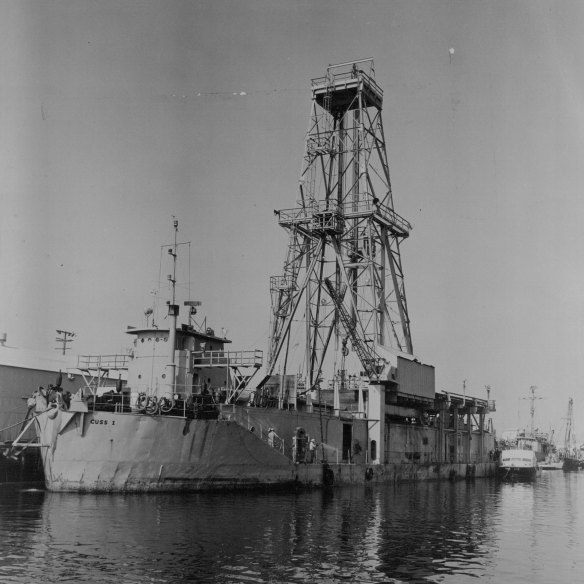
The Cuss I ship used for Project Moho.Credit: Fairfax
In the race to the Moho, though, the Russians came closest, reaching 12.2 kilometres more than a decade later. They were drilling on land, where the crust is thicker but the job more straightforward. The problem was that their instruments started melting. “The heat down there was almost twice as high as they expected,” Tkalcic says. At those depths, rock began to behave more like plastic. “It rises 25 degrees for every kilometre you go down.”
Germany faced a similar problem, abandoning its Bavarian borehole at nine kilometres in 1994 when the temperature hit 265 degrees. Today it’s still open – part tourist attraction, part art installation. (A Dutch artist had a thermally shielded microphone winched down and picked up a deep rumbling sound scientists apparently couldn’t explain.)
But momentum is now building around another push to the Moho, and this time Japan is leading the charge as part of an international exploration program. Its science agency has already drilled more than three kilometres into the sea floor, the furthest for the oceanic crust yet, using its flagship vessel Chikyu (designed to drill seven kilometres to the mantle).
Exactly where they will try is still being decided. Japan sits on four tectonic plates grinding together, Deuss says, a precarious place for earthquakes but which could be a great opportunity for drilling to the Moho. “Because there, [the Earth] will actually sag down a little,” she says, in a kind of crack in the sea or deepwater canyon. “So you could go all the way down a trench like that, deeper and deeper, and you don’t even have to drill until you hit the very bottom.”
Tkalcic says the technology for such feats finally seems in reach. “Ten years ago, we thought we’d have mantle rocks already, and it still hasn’t happened, but I was just at a symposium in Japan, and we really are close.” As with everything, what’s needed is more funding, he says. “But we’re talking a few hundred million dollars, much less than a NASA mission.”
Of course, getting to the Moho won’t solve every mystery beneath our feet. The two blobs that so perplex scientists are still almost 3000 kilometres underground, for example, one beneath Africa and the other the Pacific. “We could never actually get down there to check what they are,” says Deuss. “It’s all detective work.”
To journey deeper than the Moho, Tkalcic says, you’d need instruments and probes made of a material “that likely doesn’t exist yet”, able to withstand the same extreme conditions that forge diamonds and melt metal. That rules out humans too. “It won’t be like that movie The Core. We won’t get to ride along.”
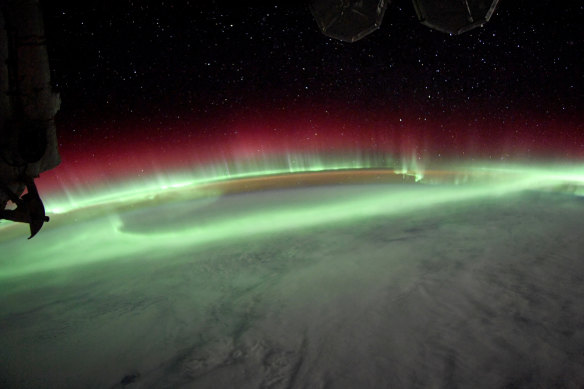
NASA astronaut Bob Hines captured an aurora – caused by the interaction of solar radiation with the magnetic field –from the International Space Station in August.Credit: Bob Hines/NASA
How does Earth’s magnetic field work?
Geophysicist Professor John Tarduno has just been hunting for ancient crystals in South America. Before that, he was in Africa. With the right crystal, of the right age, he can peer back millions of years to better understand the Earth’s magnetic field. This phenomenon at the very heart of the world shields the surface from deadly cosmic radiation and helps everything from aircraft to turtles navigate. When auroras twist in brilliant colour in the skies above the north and south poles, that’s a sign of the field kicking out those harmful solar rays.
“The crystals showed that the Earth’s magnetic field was 10 times weaker back then, as if the field itself was on the point of collapse.”
“And rocks are like the magnetic strip of a cassette tape,” Tarduno says. “Full of tiny magnetic grains. Some are perfectly formed, ideal for recording the field. We’re always searching for them.”
He and his team found “perfect crystals” of this kind in Quebec, Canada – full of tiny magnetic needles too small to see with the naked eye but still frozen in the direction of the magnetic field’s “north” when they formed 565 million years ago. Analysing them back in his magnetically shielded lab, Tarduno discovered something astonishing. “The crystals showed that the Earth’s magnetic field was 10 times weaker back then, as if the field itself was on the point of collapse.”
Yet, when he analysed other crystal records from about 30 million years later, the magnetic field had already recovered by 70 per cent – fortunate, for that was just when life was rapidly diversifying across the globe, in a period called the Cambrian explosion or Biological Bang. It also coincides, Tarduno says, with scientists’ best estimate for when the inner core was born.
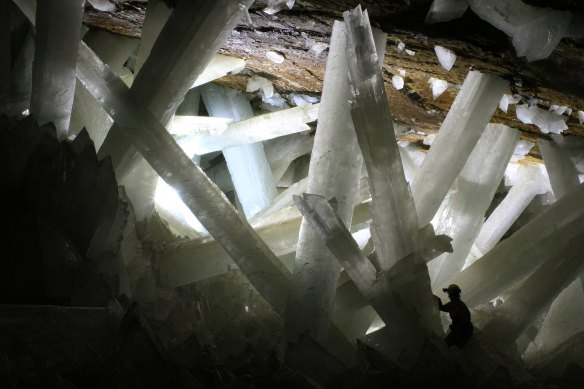
Giant crystals up to 11 metres tall have been discovered in Mexico’s Naica cave, which sits above an underground magma chamber. Credit: Alexander Van Driessche
It’s likely that the magnetic field itself first got going much earlier, he says, after the giant impact with Theia that forged the moon and turned Earth into a molten sea. That calamity may have broken up the layers within our planet, mixing them into the twisting convection you need for magnetism. “It’s easy for physicists to imagine the magnetic field starting,” once the molten core was swirling, says Tarduno. “But magnetic fields decay and fade away too.”
Instead, Earth cooled enough to begin growing a hard inner core. That growth, from liquid back to solid, actually creates its own energy, its own heat, as does the shedding of lighter particles within it when the iron crystallises, like salt expelled from freezing water. This energy churns the liquid outer core around it into a boiling sea of convection. “It’s not a river flowing smoothly from one side to another, it’s swirling,” Tarduno says, and that generates the field. The inner core has become its engine.
“Those conditions could be more of Earth’s great luck. If the composition down there had been just a little different, Earth may have met the same fate as Mars.” There the magnetic field died long ago (and today its protective atmosphere has largely leaked away).
Deuss says eventually, over billions of years, the core may eat all the way through the liquid core and the field may die. More calamities are due to befall the Earth before then, not least of all our sun growing so hot it cooks the planets around it in about one billion years, but Tarduno agrees that “as the inner core gets larger, the magnetic field could become more complicated”.
Already, every hundred thousand years or so on average (“though very much at random” Tarduno says), the field switches poles. North becomes south. It often begins with an anomaly, an area of the field pointing in the wrong direction that grows over thousands of years until it takes over, triggering a rapid reversal. One such anomaly has been detected already in the southern hemisphere, over the Atlantic, leading many scientists to predict a coming reversal.
The field can drop in intensity during these periods before jumping back up, which could spell trouble. But Tarduno says that, while the field has been waning for the past 160-odd years, the Earth’s own atmosphere still shields us well from cosmic rays during such times. “There’s no evidence of, say, a mass extinction associated with a reversal. And there have been hundreds of reversals in the last 100 million years.” The main problem could be that technology goes haywire.
Tarduno suspects the reason for reversals lies in the core-mantle boundary – with our strange blobs. The South Atlantic anomaly lines up with the African blob, which may be pushing on the outer core below it, changing the heat flow, the convection. The boundary between rock and liquid there isn’t a perfect circle inside the Earth. “It has topography”, like upside-down mountains rearing up or the bend in a river.
It’s also the most dramatic of the boundaries within the Earth, Tkalcic says, “more, even, than going from atmosphere to solid rock”. Earth isn’t perfectly symmetrical either, he says, “you have things like the blobs [affecting] how its mass, its gravity, is centred.” That causes the poles at the top and bottom of the world to wander a little. And it tangles the invisible lines of the magnetic field. When they become too tangled, he says, just as a buildup of pressure between two colliding tectonic plates triggers an earthquake, “you have a release in the system, a sudden swap”.

A newly erupted volcano in Iceland in August. Volcanoes are not special portals for human trips to the Earth’s centre (as imagined by Jules Verne) but they can throw up ancient rocks that help solve scientific mysteries.Credit: Getty Images
What other key mysteries remain?
Unlocking the secrets of our planet’s interior could help us understand life on the surface and how it got started. (Microbes have already been discovered alive deep in the heat of the crust, for example.) Meanwhile, much of the rare metals and other resources left in the Earth are lower down, and China is one of many countries strategically looking to map more of this subterranean world.
Even further down, Deuss wants to see if there’s a link between changes within the inner core and those in the magnetic field. Suspended in liquid, the inner core spins independently of the Earth, at times faster and at other times slower. Those fluctuations already seem to line up with another strange, though small, wobble of the Earth on its axis every six years. And the inner core appears to be growing faster on one side than the other.
Scientists are trying to simulate the punishing conditions at the core up in their laboratories (using diamonds and sometimes the shockwaves of powerful gas guns). Already, Japanese scientists have helped confirm theories that the inner core is a forest of crystal iron. “You basically take two diamonds and push them together, tighter and tighter,” explains Deuss. “Then you add lasers to make it hotter too. We’d been able to produce pressure and temperature but never at the same time before that scientist cracked it. The diamonds would just break.”
But she thinks more secrets could be revealed at an even smaller scale – using tiny particles born from radioactive decay called neutrinos. Most of the time, these tiny “ghosts” wing through space straight on without slowing. But every now and then they hit an atom of matter and when they do, they can tell us something about that atom, Deuss says. Finding a neutrino that has touched even one atom of the inner core could be a big jump forward for the field.
“Because now I’ve been looking at the [seismological] data and there’s just too much noise, we’ve seen as deep as we can, I think,” Deuss says. “We need next-generation detectors, like for these neutrinos; a few in the right places” such as over the ocean where the interference from radiation in the mantle is less intense. Her ideal spot? One above each of the mystery blobs, waiting to catch a stray neutrino with their signature.
Tarduno suspects these “oddities” are not the remnants of a lost planet after all, but slabs of the first supercontinent Pangea. Such a theory would complete a kind of circuit for our living Earth, he says, as things at the surface sink to the mantle, pressing on the core and, in turn, changing conditions at the surface.
But whether Earth really is just Earth or not, Tkalcic thinks Jules Verne was right about one thing: “It’s still a whole other world down there.”
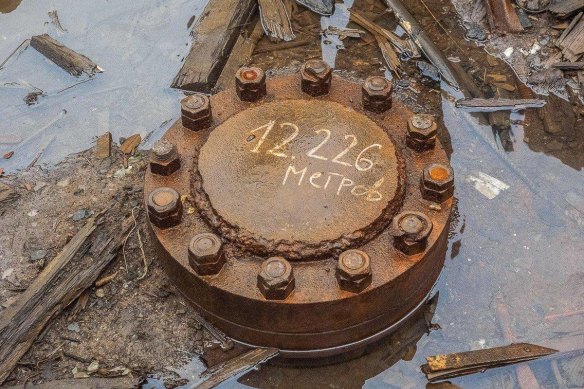
The small entrance to Russia’s borehole, the deepest hole in the world, is sealed off in the ruins of an abandoned Arctic research station.Credit: Roshan Kalpa Tharanga
Let us explain
If you'd like some expert background on an issue or a news event, drop us a line at explainers@smh.com.au or explainers@theage.com.au. Read more explainers here.